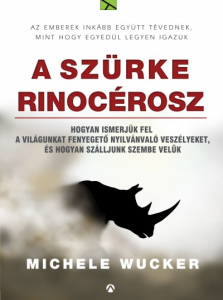Take the Gray Rhino Readiness Quiz and share with your networks.
Click BEGIN THE QUIZ below to get started.
Take the Gray Rhino Readiness Quiz and share with your networks.
Click BEGIN THE QUIZ below to get started.
 THE GRAY RHINO is now available in Hungarian translation via Athenaeum as A szürke rinocérosz: Hogyan ismerjük fel a világunkat fenyeget? nyilvánvaló veszélyeket, és hogyan szálljunk szembe velük
THE GRAY RHINO is now available in Hungarian translation via Athenaeum as A szürke rinocérosz: Hogyan ismerjük fel a világunkat fenyeget? nyilvánvaló veszélyeket, és hogyan szálljunk szembe velük
Click the book cover for more information in Hungarian.
Are you teaching THE GRAY RHINO, LOCKOUT, or WHY THE COCKS FIGHT as required reading in your high school or university course? Would you like a free 20 to 30 minute Q&A session with your students over Skype?
If so, please send a copy of your course syllabus to michele@wucker.com, along with the time and day of the week that your class meets and a few suggested days, the number of students in your class, and any other information that might be helpful. Your class must read the book ahead of the session and have prepared questions.
I’ll do my best to accommodate your top preferred dates around my other commitments and travel schedule, so the more flexible you can be, the more likely we’ll be able to find a time that works.
 One of the things I’m enjoying the most about the launch of The Gray Rhino: How to Recognize and Act on the Obvious Dangers We Ignore is the way people are embracing the concept and applying it to their work, to their personal lives, and to the policy challenges facing their communities and the planet. We all face highly obvious gray rhino threats, and we all could do better -often MUCH better- at dealing with instead of denying them.
One of the things I’m enjoying the most about the launch of The Gray Rhino: How to Recognize and Act on the Obvious Dangers We Ignore is the way people are embracing the concept and applying it to their work, to their personal lives, and to the policy challenges facing their communities and the planet. We all face highly obvious gray rhino threats, and we all could do better -often MUCH better- at dealing with instead of denying them.
In recent workshops in Milwaukee, Phoenix, and San Francisco, I enjoyed and learned from lively discussions about gray rhinos from transportation and workforce challenges to family financial planning; to geo-economic issues like China’s economy, the clashing threats of deflation and asset inflation, the impact of volatile oil prices on the Middle East and on the global economy; the impact of disruptive technologies on various industries and the employment outlook; safety and transparency problems that now look to be widespread across the auto industry, not just isolated to a couple of companies; and ongoing business issues like evolving customer preferences and cost of customer acquisition. I loved that one workshop group even came up with a new term: limping hippos -for the things that appear to be gray rhinos but turn out to be false alarms.
Scott MacDonald of the University of Connecticut has written on LinkedIn Pulse about Puerto Rico’s debt crisis as a gray rhino: “International financial markets have already seen the problem of a slow motion train wreck with Greece’s debt problem and the European Union; hopefully we are not going to relive it with Puerto Rico and the U.S. municipal bond market. More likely than not, a portion of Puerto Rican debt will have to be written off.”
Regina Rodriguez-Martin wrote on her Chicana on the Edge blog about how we can apply gray rhinos to personal life, not just to business and policy issues. “The ending of my marriage was probably a gray rhino,” she says. I often mention Regina’s quip at book talks and the audiences just love her perspective. On another serious note, she mentions a friend whose mother was dying, but her father only got past the denial stage when she passed away.
Dr. Aldemaro Romero Jr wrote “Academia is now facing a lot of gray rhinos,” in the Edwardsville Intelligencer. He cites the vulnerability of state educational institutions to falling funding and of private institutions to challenges involving diversity, access and endowment management. Students and parents can add to problems when they let a sense of entitlement get in the way.
In Norway, leadership consultant Lise Strand Bjarkli uses the gray rhino to talk about how businesses face market disruptions including the Fourth Industrial Revolution and “the awareness, willingness and ability each and one of us could summon to act upon swans, elephants or grey rhinos.”
A reader who emailed me this week feels that nuclear weapons are an important gray rhino, a conclusion that many respondents to the World Economic Forum’s 2016 Global Risks Report certainly shared.
Questions from audiences and readers always give me lots of food for thought. One of the first questions I nearly always get is whether Donald Trump is a gray rhino. (Look at all of the failed attempts to stop his rise; more important, though, is to look at the gray rhinos that made it possible.) What about the “Really Big One” earthquake along the Cascadian subduction zone, the subject of a Pulitzer Prize winning New Yorker article? (Highly scientific consensus: the really big one most likely is a black swan in our lifetime, but likely a gray rhino in the future; and smaller quakes are definitely gray rhinos.) The asteroid Apophis or other asteroids that might strike earth? (NASA scientists see the risk as extremely low, though several recent news articles have placed it higher.) Our polarized and paralyzed political system? A resounding YES.
That’s the great thing about the gray rhino concept: not every person may see the same gray rhinos, but the principle and framework can help everyone to take a more serious look at the things right in front of us that we don’t give the attention that they deserve.
So, I ask today: What is your gray rhino? I’d love to hear about it.
Read and share this post on LinkedIn Pulse.
My biggest takeaway from the 2013 Annual Meeting of the World Economic Forum in Davos was that we need to find ways to encourage long-term thinking -and acting. Read more HERE in this February 5th post to the World Economic Forum blog.
Down with Short Termism; Long Live the Long Term
If only I had a nickel for every time during the World Economic Forum Annual Meeting 2013 that participants held up short-term thinking and actions as the bogeyman standing in the way of the Meeting’s Holy Grail: dynamic resilience.
Delivering a scathing assessment of the European Union’s response to the euro crisis, especially in the early stages, Italy’s Prime Minister Mario Monti blamed it for short-term thinking when “leadership is the opposite of short termism.” IMF Managing Director Christine Lagarde similarly urged longer-term policy strategies: “If we look beyond the short term, we would indeed move past the crisis,” she said.
This is hardly the first time anyone has criticized short-term thinking as a danger. But the chorus of voices creates a real opportunity to move from talking to doing. Let’s use it to create the right incentives to encourage politicians, businesses, investors – and, for that matter, individuals – to think and act for the long term as well as for immediate priorities.
Continue reading “Davos 2013 -Balance Short with Long Term Thinking”
Today’s debt crises among European sovereigns and US underwater mortgage holders both have much in common with a similar chronicle of debt foretold in Argentina a decade ago: the answer that involves the least amount of pain is a swift restructuring. In “Chronicle of a Debt Foretold,” a new paper for the World Economic Roundtable, organized jointly by the World Policy Institute and the Economic Growth Program of the New America Foundation, I argue that the answer is similar to the stitch in time that was proposed for Argentina, on which policy makers failed to act, modeled on the Brady Plan debt restructurings that resolved the 1980s sovereign debt crisis. We need a new Brady Plan for both the troubled European sovereign debtors, and for US underwater mortgages, before we lose another decade, as we did in the 1980s.
I’ll be speaking at the “Right to Move: Debating the Ethics of Global Migration” conference at Sophia University in Tokyo, Japan, December 12-13th, 2009, organized by Carnegie Council Global Policy Innovations and Sophia University Institute of Comparative Culture.
Here’s a description of my presentation:
Linking Ethics and Self-Interest in Human Mobility
Facing demographic and economic challenges, countries around the world are reconsidering the policies that govern migrant rights: the basis on which people are allowed to enter a country, the access that non-citizens have to services and rights, and the ability of non-citizens to naturalize. What are the consequences for citizens, societies, and economies of the decisions they make about who gets the right to move? How do limitations on the rights of others to move to a country, to become citizens, and to participate in the workforce and in social and political structures affect established citizens of those countries? What are the most ethical regimes involving human mobility—and how do they compare to policies that might maximize the well-being of citizens and non-citizens?
Panel descriptions and biographies are HERE
You can find the full agenda HERE
As many of you know, I was back and forth to Washington, DC many times over the past year to take part in an unusual gathering of scholars and thinkers on immigration policy. The Brookings-Duke Immigration Policy Roundtable organizers, Noah Pickus, Peter Skerry and Bill Galston convened a group as diverse as possible without members being likely to strangle each other by being in the same room –but they weren’t far off! The idea was to see what this disparate bunch could agree on (or at least agree to disagree on), in hopes that it might provide some guidance to the Obama administration as it tackles long-overdue immigration reform. We made it through somehow with a report that would have been different had I (or any of us) written it ourselves. Nevertheless, it gives a pretty good sense of some of the tradeoffs that might be politically feasible and result in a policy that, while not perfect, would significantly improve upon the mess that we have now.
That report, available in PDF format here, was released October 6. Links to the executive summary, the Spanish version, and the Brookings launch event transcript are available here. I’ll be part of a panel discussing it further at the Council on Foreign Relations in Washington, DC on October 23.
Here’s more information about the report:
The Obama administration has committed itself to immigration reform. Yet despite all the shortcomings of current policy — threats to the rule of law, exploitation of vulnerable newcomers, real and perceived competition with Americans for jobs and public resources — reasonable compromise on immigration will be exceedingly difficult. The divide between elite and public opinion on this issue remains deep and wide. It is a critical factor in the lack of trust that pervades today’s political culture.
This distrust was readily apparent in November 2008 when the Immigration Policy Roundtable first convened its twenty participants. The Roundtable is a joint undertaking of the Brookings Institution and the Kenan Institute for Ethics at Duke University. The group’s distinctive feature is that its members came to the table with divergent, often conflicting perspectives on immigration. In fact, the range of political and ideological views represented at the Roundtable is unprecedented in recent immigration policymaking. Continue reading ““Breaking the Immigration Stalemate” report released”